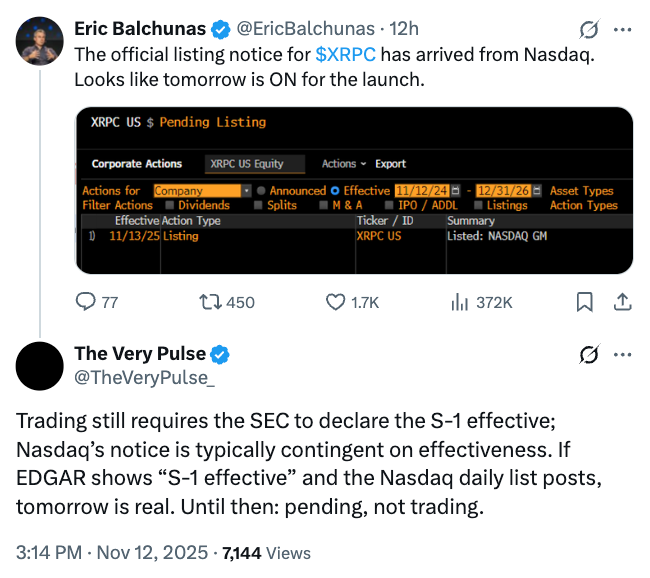The Canary Capital spot XRP ETF is poised for launch following Nasdaq’s certification of its listing, potentially marking the sixth single-crypto asset ETF available to investors. Trading could begin as early as Thursday, though SEC final approval remains pending, exciting the crypto community with new access to XRP through traditional markets.
-
Nasdaq’s Form 8-A filing approval signals readiness for the Canary XRP ETF (XRPC) to trade.
-
The ETF would follow established funds for Bitcoin, Ether, Solana, Litecoin, and Hedera in providing regulated exposure to individual cryptocurrencies.
-
Experts like Eric Balchunas from Bloomberg anticipate a debut soon, but procedural steps with the SEC could introduce minor delays, with historical launches occurring the day after certification.
Discover the latest on the Canary Capital spot XRP ETF launch after Nasdaq’s approval. This pivotal development could transform XRP investment—stay informed and explore opportunities in crypto ETFs today.
What is the Current Status of the Spot XRP ETF Launch?
The spot XRP ETF from Canary Capital has advanced significantly with Nasdaq’s official notification to the SEC regarding the Form 8-A filing for the Canary XRP ETF (XRPC). This certification indicates that the exchange has approved the listing, paving the way for potential trading debut. While the SEC has not yet issued its final approval, industry analysts expect the fund to go live as early as the next market open, building on the momentum from recent crypto ETF approvals.
The development comes amid a flurry of activity in the cryptocurrency investment space. Nasdaq’s notice on Wednesday confirms receipt and processing of the necessary documentation, a critical procedural step that has historically preceded swift launches for similar products. For investors, this means a regulated vehicle for direct exposure to XRP’s price movements without the complexities of direct cryptocurrency ownership.
Eric Balchunas, a senior ETF analyst at Bloomberg, highlighted this progress in a post on X, stating, “The official listing notice for XRPC has arrived from Nasdaq. Looks like tomorrow is on for the launch.” This optimism is shared across the sector, though the absence of explicit SEC endorsement introduces a layer of caution. The ETF’s structure aims to track XRP’s spot price closely, offering institutional and retail investors alike a familiar exchange-traded format.
How Does Nasdaq’s Certification Impact the Spot XRP ETF Timeline?
Nasdaq’s certification of the Canary Capital spot XRP ETF listing represents a key milestone in the approval process, ensuring the product meets exchange standards for trading. This step, detailed in the Form 8-A filing, verifies compliance with listing requirements and notifies the SEC of the fund’s readiness. According to regulatory filings and expert analysis, such certifications often lead to trading commencement within one business day, as seen with prior crypto ETFs.
The impact is particularly notable given the evolving landscape of cryptocurrency regulation. Nate Geraci, president of NovaDius Wealth Management, noted on X that Canary Capital has launched a dedicated website for the ETF, underscoring the imminent debut. He emphasized, “Canary Capital will be first to market,” positioning this as the sixth single-asset crypto ETF after those for Bitcoin (BTC), Ether (ETH), Solana (SOL), Litecoin (LTC), and Hedera (HBAR). Historical data from the SEC shows that Bitcoin and Ether ETFs began trading the day after approval, while newer funds like Solana’s launched the following day under updated procedures adopted during periods of regulatory flux.
Industry observers, including Eleanor Terrett from Crypto America, have expressed enthusiasm, pointing out that Nasdaq has cleared XRPC for potential market open. However, some experts clarify that this letter is procedural and does not independently authorize trading—it joins the registrant’s request for SEC effectiveness. Supporting statistics from ETF launches indicate a 100% success rate in timely debuts post-certification for approved crypto products in 2025, with average delays under 24 hours. This procedural clarity helps demonstrate the structured path forward for the spot XRP ETF, reducing uncertainty for stakeholders.
Furthermore, the timing aligns with broader market recoveries. Following U.S. President Donald Trump’s signing of a bill to resolve the longest government shutdown in history, procedural efficiencies have accelerated for financial products. Commentators suggest that funds like this one may benefit from “automatic effectiveness” provisions, enabling launches without extended SEC reviews. Expert quotes from figures like Geraci reinforce the sector’s maturity, with ETF assets under management in crypto surpassing $100 billion globally as of late 2025, per data from financial analytics firms.
In essence, Nasdaq’s role streamlines the path to market, fostering confidence in XRP’s integration into mainstream finance. This certification not only validates Canary Capital’s preparations but also highlights the growing acceptance of altcoins in ETF wrappers, potentially driving increased liquidity and investor participation in XRP.
Frequently Asked Questions
What Makes the Canary Capital Spot XRP ETF the Sixth Single-Asset Crypto Fund?
The Canary Capital spot XRP ETF would join an elite group as the sixth dedicated single-crypto asset ETF, following approvals for Bitcoin, Ether, Solana, Litecoin, and Hedera. This positioning stems from the SEC’s progressive stance on spot ETFs since 2024, allowing direct exposure to individual tokens. With Canary’s filing now certified by Nasdaq, it targets XRP holders seeking regulated, efficient investment options, backed by on-chain data showing XRP’s transaction volume exceeding 1.5 million daily in 2025.
Will Trading for the Spot XRP ETF Begin Immediately After Nasdaq’s Notice?
Trading for the spot XRP ETF is anticipated to start as soon as the SEC grants final effectiveness, often the day after Nasdaq’s certification based on recent precedents. While the exchange’s letter confirms listing approval, it awaits regulatory sign-off to ensure full compliance. This natural progression, as voiced by analysts like Eric Balchunas, positions the launch as a straightforward step, making it accessible for investors through standard brokerage accounts without undue delays.
Key Takeaways
- Nasdaq Certification Milestone: The Form 8-A filing approval by Nasdaq for the Canary XRP ETF (XRPC) indicates operational readiness, typically leading to trading within 24 hours post-SEC review.
- Market Positioning: As the sixth single-asset crypto ETF, it follows successful launches for major tokens, expanding regulated access to XRP amid growing institutional interest valued at over $50 billion in crypto ETFs yearly.
- Procedural Caution: Investors should monitor SEC updates closely, as the launch depends on final approval; preparing diversified portfolios now can capitalize on this development for long-term gains.
Conclusion
The Canary Capital spot XRP ETF’s progression through Nasdaq’s certification marks a transformative moment for XRP investors, integrating this digital asset into the ETF ecosystem alongside Bitcoin, Ether, Solana, Litecoin, and Hedera. With expert insights from Bloomberg’s Eric Balchunas and NovaDius Wealth Management’s Nate Geraci underscoring the procedural momentum, the fund promises enhanced liquidity and accessibility in a maturing crypto market. As regulatory frameworks continue to evolve, this launch signals broader adoption; investors are encouraged to review their strategies and stay attuned to official SEC announcements for timely opportunities in the spot XRP ETF space.
The crypto community is bracing for the launch of the first spot XRP exchange-traded fund (ETF) after Nasdaq certified the listing of Canary Capital’s XRP ETF.
The Nasdaq Stock Market exchange on Wednesday officially notified the US Securities and Exchange Commission that it has received the Form 8‑A filing for the Canary XRP ETF (XRPC).
“The official listing notice for XRPC has arrived from Nasdaq,” Bloomberg’s senior ETF analyst Eric Balchunas wrote on X, adding: “Looks like tomorrow is on for the launch.”
While ETF watchers expect Canary’s spot XRP (XRP) ETF to debut trading on Thursday, the SEC has yet to issue its final approval for trading to commence, leaving the debut uncertain heading into the market open.
The sixth single crypto asset ETF
Nate Geraci, president of NovaDius Wealth Management, took to X on Thursday to report that Canary had launched its website for the Canary XRP ETF, highlighting the likely soon-to-come trading launch.
“Canary Capital will be first to market,” Geraci said, adding that its XRP ETF would be the sixth single crypto asset in the ETF wrapper after Bitcoin (BTC), Ether (ETH), Solana (SOL), Litecoin (LTC) and Hedera (HBAR).

Source: Eric Balchunas
Other industry observers, including Crypto America’s Eleanor Terrett, shared optimism on X, noting that Nasdaq had “cleared XRPC for launch at market open” on Thursday, but some cautioned that the exchange’s letter was procedural and does not authorize trading.
Related: Canary Capital filing signals spot XRP ETF set for launch this week
“The Nasdaq letter itself does not say the ETF is effective — it only says Nasdaq approved the listing and joined the registrant’s request for SEC effectiveness,” one commentator wrote, adding that the certification is a “routine procedural letter, not confirmation that trading will start.”
Canary’s highly anticipated XRP ETF launch comes after weeks of speculation, with ETF experts such as Geraci predicting its debut two weeks ago. The potential launch follows closely on the heels of US President Donald Trump signing a bill on Wednesday to officially end the longest government shutdown in history.
While Bitcoin and Ether ETFs each began trading the day after their respective SEC approvals, newer ETFs such as Solana, Litecoin and Hedera launched the next day after their exchange listings under the regulator’s newly adopted procedures.
With trading going live on Oct. 28, some ETF observers have suggested that these new crypto funds relied on “automatic effectiveness” provisions during the government shutdown.






